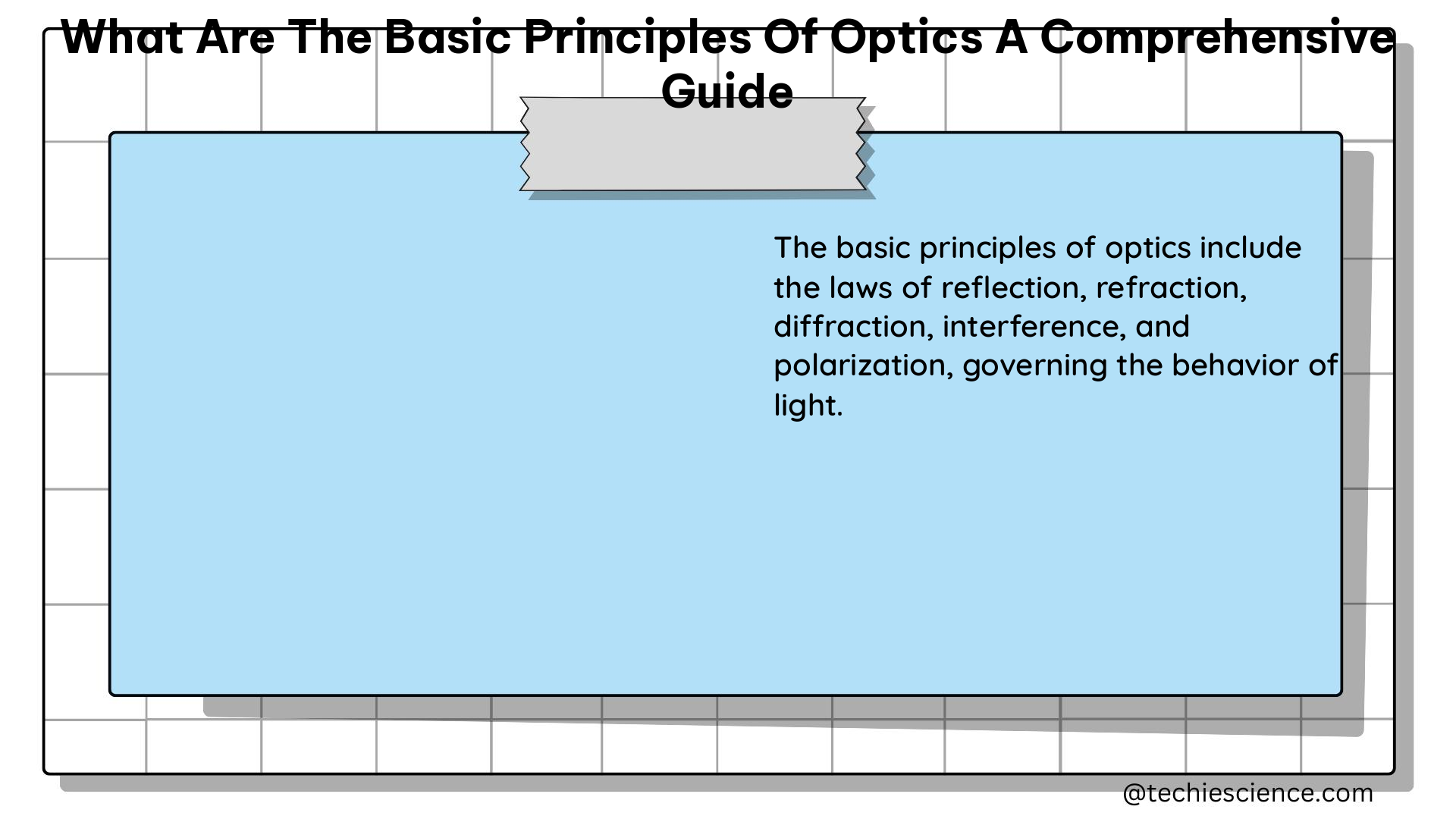The field of optics encompasses a wide range of phenomena and concepts related to the behavior of light, which is an electromagnetic wave. This comprehensive guide delves into the fundamental principles of optics, providing a deep understanding of the wave nature of light, refraction, reflection, interference, polarization, diffraction, and dispersion. Through detailed explanations, formulas, examples, and numerical problems, this guide aims to equip physics students with a robust knowledge of the basic principles of optics.
Wave Nature of Light
Light exhibits wave-like behavior, with properties such as wavelength, frequency, and speed. The relationship between these properties is given by the equation:
c = λν
where:
– c is the speed of light (approximately 3 × 10^8 m/s)
– λ is the wavelength of the light
– ν is the frequency of the light
This equation demonstrates the inverse relationship between wavelength and frequency, as the speed of light remains constant in a given medium.
Refraction

When light passes through a medium with a different refractive index, it changes direction. The amount of bending is described by Snell’s law:
n1 sin θ1 = n2 sin θ2
where:
– n1 and n2 are the refractive indices of the two media
– θ1 and θ2 are the angles of incidence and refraction, respectively
The refractive index of a medium is a measure of how much the speed of light is reduced in that medium compared to the speed of light in a vacuum.
Example: A ray of light traveling in air (n = 1.00) strikes a glass surface (n = 1.50) at an angle of 30 degrees. Using Snell’s law, we can calculate the angle of refraction as:
sin θ2 = (n1/n2) sin θ1 = (1.00/1.50) sin 30 = 0.333
θ2 = arcsin(0.333) = 19.47 degrees
Reflection
When light hits a smooth surface, it can be reflected. The angle of incidence is equal to the angle of reflection, according to the law of reflection:
θi = θr
where θi is the angle of incidence and θr is the angle of reflection.
Interference
When two or more light waves overlap, they can interfere with each other, leading to constructive or destructive interference. The resulting intensity is given by the equation:
I = I1 + I2 + 2√(I1I2) cos δ
where:
– I1 and I2 are the intensities of the two waves
– δ is the phase difference between the waves
Numerical Problem: Two polarized light waves with intensities I1 = 2 mW/cm^2 and I2 = 3 mW/cm^2 are combined. What is the intensity of the resulting wave if the phase difference is δ = π/2?
Using the formula for interference, we can calculate the intensity as:
I = I1 + I2 + 2√(I1I2) cos δ
= 2 + 3 + 2√(2 × 3) cos(π/2)
= 5 - 2√6 ≈ 1.54 mW/cm^2
Polarization
Light waves can be polarized, meaning that their electric field vectors oscillate in a single plane. Polarization can be described using the Stokes parameters, which are four quantities that fully characterize the polarization state of a light wave.
Diffraction
When light passes through a narrow opening or around an obstacle, it can spread out and form a diffraction pattern. The angular width of the central maximum in a single-slit diffraction pattern is given by:
θ = λ/d
where:
– λ is the wavelength of the light
– d is the width of the slit
Dispersion
Different colors of light have different speeds in a medium, leading to dispersion and the formation of rainbows. The dispersion relation for a medium is given by:
n(λ) = c/v(λ)
where:
– n(λ) is the refractive index of the medium at wavelength λ
– v(λ) is the speed of light in the medium at wavelength λ
This equation demonstrates how the refractive index of a medium varies with the wavelength of light, resulting in the separation of white light into its constituent colors.
By understanding these fundamental principles of optics, physics students can develop a comprehensive understanding of the behavior of light and its applications in various fields, such as imaging, communication, and spectroscopy.
References
- Principles of Nano-Optics (2nd edition) by Lukas Novotny and Bert Hecht
- Principles of Optics (7th edition) by Max Born and Emil Wolf
- Fundamentals of Photonics by Bahaa E. A. Saleh and Malvin Carl Teich

The lambdageeks.com Core SME Team is a group of experienced subject matter experts from diverse scientific and technical fields including Physics, Chemistry, Technology,Electronics & Electrical Engineering, Automotive, Mechanical Engineering. Our team collaborates to create high-quality, well-researched articles on a wide range of science and technology topics for the lambdageeks.com website.
All Our Senior SME are having more than 7 Years of experience in the respective fields . They are either Working Industry Professionals or assocaited With different Universities. Refer Our Authors Page to get to know About our Core SMEs.